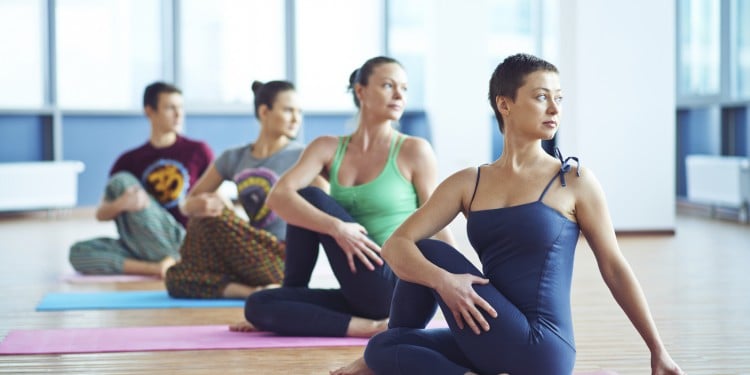Most of us sit...a lot. We sit when we drive to work, we sit at a desk, we sit at home. Even cycling, or at the gym with certain ab and weight training exercises, our hips are flexed and can become tight. It doesn't matter whether the movement is when you are exercising or at rest.
Excess hip flexion increases tension in your hip complex and the less active you are (the more you sit) can mean your muscles are short and weak. Yoga is a great way to build balance in your body as well as releasing tension. There are so many benefits to the practice of yoga. Its all encompassing nature and time tested success, with over 5,000 years of refinement, has made yoga a transformative practice that continues to gain in popularity.
In order for your body to be balanced and to feel and move well, you must stretch and strengthen opposing muscles. This should be a regular practice so that your musculoskeletal system will remain balanced over time. Many of us carry tension in our body that is difficult to release. We spend much of our time flexing or stretching our muscles, but many of us, including those with chronic pain, do not get the release needed to reset our movement patterns. Yoga focuses on breath and mindfulness, giving this practice the power to really transform the body's potential. After doing the hip opening poses in this article, you will begin to transform hip tension into relaxation and, ultimately, create balance in your structure.
If you want to apply what you learn here and help others on a professional basis, consider checking out the NASM course on stretching and flexibility.
General Anatomy of the Hips
Many times when you hear the word hip opener in yoga people think of the front or sides of the hip because they tend to be the tightest. But there are actually four groups of muscles that make up the hip complex: the iliopsoas (hip flexors), the external rotators of the hip, the glutes and the adductors. The iliopsoas group is comprised of the psoas muscle and the iliacus. The external hip rotator group is composed of gemellus superior and gemellus inferior, obturator internus and obturator externus, piriformis, and quadratus femoris. The gluteal group is made up of the gluteus maximus, gluteus medius, gluteus minimus and tensor fascia latae (TFL). Finally we have the adductor group which is a combination of adductor brevis, adductor longus, adductor magnus, pectineus and gracilis.
When your hips are balanced you will feel more mobile and will likely have less pain, which leads to increased happiness and wellbeing. Discomfort or pain associated with tight hips not only includes outer hip and front of the hip pain, but it also affects your low back (such as nerve compression and sciatica) and can lead to other kinetic chain issues.
The two most common tight hip groups are the iliopsoas and external hip rotators. When hip flexors and external hip rotators are tight, the next closest place of mobility will be sacrificed, usually the lumbar spine. This can lead to an increased arch in the low back, which means a shortening of the back extensors and the potential risk for disc issues or lumbar spine compression.
See also: Hip Impingement Unhinged
While all of the hip openers below are focused on these four muscle groups, the surrounding muscles of the trunk and lower body will also experience some benefit.
HIP OPENERS
1.) Half Pigeon Pose
From Downward Facing Dog, reach your right leg high, then draw your right knee behind your right wrist. You can flex your right foot or press the top of your foot into the ground to help support your knee. Walk your hands back by your hips and take a moment to square your hips forward. If your right hip is lifted off of the earth, place a block or towel under to support your hips.
Slowly lower your torso toward the earth. You should feel sensation in your outer right hip. If you feel this in your right knee come out of the pose. Flip over onto your back, bend your knees, place your feet on the ground and cross your right ankle over your left thigh. Press your right hand into your right thigh to increase sensation.
Targeted Muscle Group: External Rotators of the Hip and Gluteals
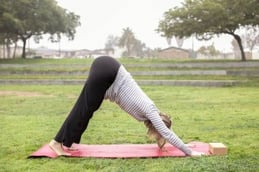 Downward Facing Dog
Downward Facing Dog
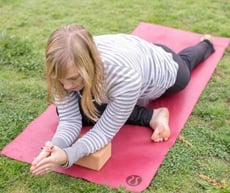 Half Pigeon
Half Pigeon
2.) Cow Face Pose (Gomukhasana) Supine Variation
Lay supine with your knees bent and both feet on the earth. Cross your right knee over your left and grab your ankles or feet. Try to keep your sacrum down on the earth and hug your knees toward your chest. You can adjust the height of your feet to access more sensation.
Targeted Muscle Group: Gluteals and External Hip Rotators
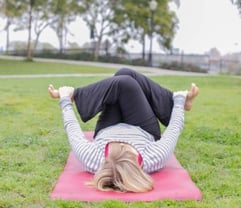 Cow Face Pose
Cow Face Pose
3.) Runner's Lunge
From Downward Facing Dog reach your right leg high, then step your right foot forward and to the outside of your right hand, bringing your palms to the inside of your right foot. Reach your heart and hips forward and then lower them toward the ground (option to drop your back knee down). Make sure your right foot is under your knee or slightly in front of it. You should feel sensation at the front of your left hip.
Targeted Muscle Group: Gluteals and Iliopsoas
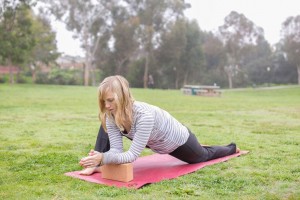 Runners Lunge
Runners Lunge
4.) Half Lord of the Fishes Pose (Ardha Matsyendrasana)
Start seated with your legs extended out long in front of you. Step your right foot outside of your left hip and draw your left heel toward your right hip. Sit up tall. Place your right hand behind your hips and hook your left elbow to the outside of your right thigh. (Opt for a straight leg if it's in your practice.)
Targeted Muscle Group: External Hip Rotators and Gluteals
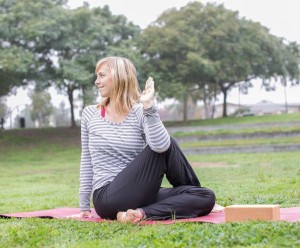 Lord of the Fishes Pose
Lord of the Fishes Pose
5.) Crescent Lunge (Anjaneyasana) Variation, Lateral Bend
From Downward Facing Dog, lift your right leg high, then step through into a low lunge, and lower your back knee onto the ground. Stack your left knee, hips and shoulders. Lift your left arm high and then laterally bend to your right. You can push your hip slightly left to deepen the stretch.
Targeted Muscle Group: Gluteals with an emphasis on the TFL
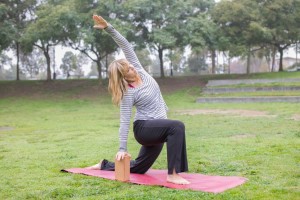 Crescent Lunge Variation with Lateral Bend
Crescent Lunge Variation with Lateral Bend

